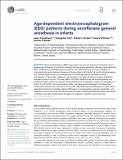Age-dependent electroencephalogram (EEG) patterns during sevoflurane general anesthesia in infants
Author(s)
Cornelissen, Laura; Kim, Seong-Eun; Purdon, Patrick L.; Brown, Emery N.; Berde, Charles B.
DownloadCornelissen-2015-Age-dependent electr.pdf (5.001Mb)
PUBLISHER_CC
Publisher with Creative Commons License
Creative Commons Attribution
Terms of use
Metadata
Show full item recordAbstract
Electroencephalogram (EEG) approaches may provide important information about developmental changes in brain-state dynamics during general anesthesia. We used multi-electrode EEG, analyzed with multitaper spectral methods and video recording of body movement to characterize the spatio-temporal dynamics of brain activity in 36 infants 0–6 months old when awake, and during maintenance of and emergence from sevoflurane general anesthesia. During maintenance: (1) slow-delta oscillations were present in all ages; (2) theta and alpha oscillations emerged around 4 months; (3) unlike adults, all infants lacked frontal alpha predominance and coherence. Alpha power was greatest during maintenance, compared to awake and emergence in infants at 4–6 months. During emergence, theta and alpha power decreased with decreasing sevoflurane concentration in infants at 4–6 months. These EEG dynamic differences are likely due to developmental factors including regional differences in synaptogenesis, glucose metabolism, and myelination across the cortex. We demonstrate the need to apply age-adjusted analytic approaches to develop neurophysiologic-based strategies for pediatric anesthetic state monitoring.
Date issued
2015-06Department
Massachusetts Institute of Technology. Department of Brain and Cognitive SciencesJournal
eLife
Publisher
eLife Sciences Publications, Ltd.
Citation
Cornelissen, Laura, Seong-Eun Kim, Patrick L Purdon, Emery N Brown, and Charles B Berde. “Age-Dependent Electroencephalogram (EEG) Patterns During Sevoflurane General Anesthesia in Infants.” eLife 4 (June 23, 2015).
Version: Final published version
ISSN
2050-084X